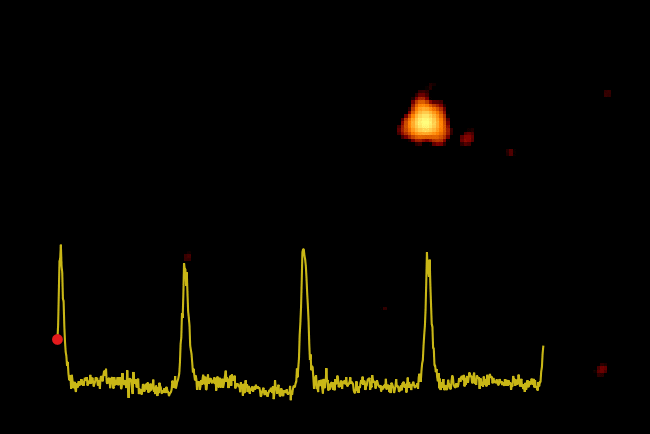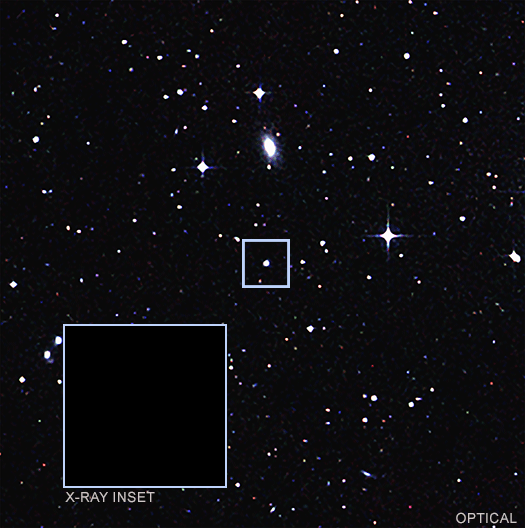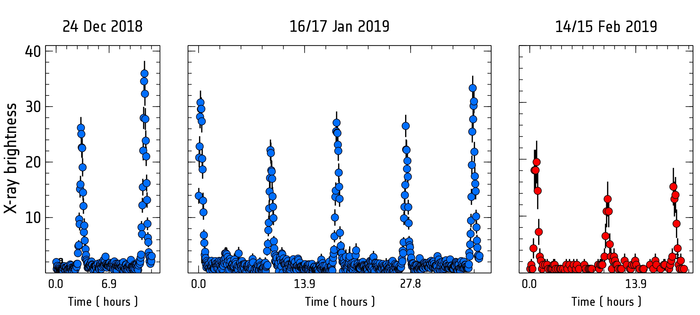

An X-ray view of the active black hole at the core of distant galaxy GSN 069, about 250 million light-years away. The upper part of the animation shows observations from ESA’s X-ray space telescope XMM-Newton. The graph in the lower part shows variations of the X-ray brightness of the black hole relative to its ‘dormant’ level. Read more about this image, which is via ESA/XMM-Newton/G. Miniutti and M. Giustini.
ESA said on September 11, 2019, that its X-ray space telescope XMM-Newton has detected never-before-seen periodic flares of X-ray radiation from a giant black hole in a distant galaxy. These scientists said in a statement that the flares:
… could help explain some enigmatic behaviors of active black holes
Active black holes are those that are still actively swallowing material – stars, gas, dust – supplied by their home galaxies. We tend to see active supermassive black holes – like the one observed to flare in a galaxy known as GSN 069, located about 250 million light-years away – in distant galaxies, in contrast to the more quiescent supermassive black hole at the center of our own Milky Way (although even the Milky Way’s central black hole appeared to gobble something up earlier this year). Of the flares seen coming from the central black hole in GSN 069, astronomers said:
On December 24, 2018, the source was seen to suddenly increase its brightness by up to a factor of 100, then dimmed back to its normal levels within one hour and lit up again nine hours later.
Giovanni Miniutti, of the Centro de Astrobiología in Madrid, Spain, is lead author of a new paper published September 11 in the peer-reviewed journal Nature. He said:
It was completely unexpected. Giant black holes regularly flicker like a candle but the rapid, repeating changes seen in GSN 069 from December onwards are something completely new.
After word got around that this black hole was flaring, other telescopes were turned in its direction. XMM-Newton performed follow-up observations in the following couple of months, as did NASA’s Chandra X-ray observatory. These telescopes confirmed:
… that the distant black hole was still keeping the tempo, emitting nearly periodic bursts of X-rays every nine hours.
The researchers are calling the new phenomenon “quasi-periodic eruptions”, or QPEs.

Optical and X-ray view of active galaxy GSN 069. More about this image. Image via ESA.
You’ve probably heard that black holes are black because no light can escape them. So what is doing the flaring? The flares are coming from the process of accretion. It happens just before the gas, dust or stellar debris falls past the point of no return, known as the event horizon. Prior to that ultimate plunge over the event horizon, the material forms a flattened ring of spinning matter, known as an accretion disk. Miniutti explained that the X-ray flares:
… come from material that is being accreted into the black hole and heats up in the process.
There are various mechanisms in the accretion disk that could give rise to this type of quasi-periodic signal, potentially linked to instabilities in the accretion flow close to the central black hole.
Alternatively, the eruptions could be due to the interaction of the disk material with a second body – another black hole or perhaps the remnant of a star previously disrupted by the black hole.
Giovanni and colleagues said that – although no one has observed this phenomenon before – the periodic flares like those just seen might be common in the universe. Their statement explained:
It is possible that the phenomenon had not been identified before because most black holes at the cores of distant galaxies, with masses millions to billions of times the mass of our sun, are much larger than the one in GSN 069, which is only about 400,000 times more massive than our sun.
The bigger and more massive the black hole, the slower the fluctuations in brightness it can display, so a typical supermassive black hole would erupt not every nine hours, but every few months or years. This would make detection unlikely as observations rarely span such long periods of time.
They said that quasi-periodic eruptions like those found in GSN 069 could provide a natural framework to interpret some puzzling patterns observed in a significant fraction of active black holes, whose brightness seems to vary too fast to be easily explained by current theoretical models. Miniutti said:
We know of many massive black holes whose brightness rises or decays by very large factors within days or months, while we would expect them to vary at a much slower pace.
But if some of this variability corresponds to the rise or decay phases of eruptions similar to those discovered in GSN 069, then the fast variability of these systems, which appears currently unfeasible, could naturally be accounted for.
New data and further studies will tell if this analogy really holds.

X-ray flares from active galaxy GSN 069. More about this image. Image via ESA/XMM-Newton; NASA/CXC; G. Miniutti (CAB, CSIC-INTA, Spain).
The quasi-periodic eruptions spotted in GSN 069 could also explain other intriguing properties observed in the X-ray emission from nearly all bright, accreting supermassive black holes, which you can read about at ESA Space News.
For now, this team of astronomers is trying to organize their studies of the distant galaxy GSN 069; for example, they are trying to pinpoint this galaxy’s defining properties at the time when the periodic eruptions were first detected. Norbert Schartel, ESA’s XMM-Newton project scientist, said:
GSN 069 is an extremely fascinating source, with the potential to become a reference in the field of black hole accretion.
Knowing what to look for, they said, will also help them more efficiently use X-ray telescopes like XMM-Newton and Chandra to search for more quasi-periodic eruptions from other supermassive black holes in other distant galaxies. Margherita Giustini of Madrid’s Centro de Astrobiología – a study co-author – said the goal is:
… to further understand the physical origin of this new phenomenon.
Bottom line: In late 2018, the supermassive black hole in the galaxy GSN 069 – about 250 million light-years away – was seen to suddenly increase its brightness by up to a factor 100, then dim back to its normal levels within one hour, and then light up again nine hours later. Since then it has continued these quasi-periodic flares. Scientists want to know what’s causing them.
Source: Nine-hour X-ray quasi-periodic eruptions from a low-mass black hole galactic nucleus
from EarthSky https://ift.tt/2O3HjMn


An X-ray view of the active black hole at the core of distant galaxy GSN 069, about 250 million light-years away. The upper part of the animation shows observations from ESA’s X-ray space telescope XMM-Newton. The graph in the lower part shows variations of the X-ray brightness of the black hole relative to its ‘dormant’ level. Read more about this image, which is via ESA/XMM-Newton/G. Miniutti and M. Giustini.
ESA said on September 11, 2019, that its X-ray space telescope XMM-Newton has detected never-before-seen periodic flares of X-ray radiation from a giant black hole in a distant galaxy. These scientists said in a statement that the flares:
… could help explain some enigmatic behaviors of active black holes
Active black holes are those that are still actively swallowing material – stars, gas, dust – supplied by their home galaxies. We tend to see active supermassive black holes – like the one observed to flare in a galaxy known as GSN 069, located about 250 million light-years away – in distant galaxies, in contrast to the more quiescent supermassive black hole at the center of our own Milky Way (although even the Milky Way’s central black hole appeared to gobble something up earlier this year). Of the flares seen coming from the central black hole in GSN 069, astronomers said:
On December 24, 2018, the source was seen to suddenly increase its brightness by up to a factor of 100, then dimmed back to its normal levels within one hour and lit up again nine hours later.
Giovanni Miniutti, of the Centro de Astrobiología in Madrid, Spain, is lead author of a new paper published September 11 in the peer-reviewed journal Nature. He said:
It was completely unexpected. Giant black holes regularly flicker like a candle but the rapid, repeating changes seen in GSN 069 from December onwards are something completely new.
After word got around that this black hole was flaring, other telescopes were turned in its direction. XMM-Newton performed follow-up observations in the following couple of months, as did NASA’s Chandra X-ray observatory. These telescopes confirmed:
… that the distant black hole was still keeping the tempo, emitting nearly periodic bursts of X-rays every nine hours.
The researchers are calling the new phenomenon “quasi-periodic eruptions”, or QPEs.

Optical and X-ray view of active galaxy GSN 069. More about this image. Image via ESA.
You’ve probably heard that black holes are black because no light can escape them. So what is doing the flaring? The flares are coming from the process of accretion. It happens just before the gas, dust or stellar debris falls past the point of no return, known as the event horizon. Prior to that ultimate plunge over the event horizon, the material forms a flattened ring of spinning matter, known as an accretion disk. Miniutti explained that the X-ray flares:
… come from material that is being accreted into the black hole and heats up in the process.
There are various mechanisms in the accretion disk that could give rise to this type of quasi-periodic signal, potentially linked to instabilities in the accretion flow close to the central black hole.
Alternatively, the eruptions could be due to the interaction of the disk material with a second body – another black hole or perhaps the remnant of a star previously disrupted by the black hole.
Giovanni and colleagues said that – although no one has observed this phenomenon before – the periodic flares like those just seen might be common in the universe. Their statement explained:
It is possible that the phenomenon had not been identified before because most black holes at the cores of distant galaxies, with masses millions to billions of times the mass of our sun, are much larger than the one in GSN 069, which is only about 400,000 times more massive than our sun.
The bigger and more massive the black hole, the slower the fluctuations in brightness it can display, so a typical supermassive black hole would erupt not every nine hours, but every few months or years. This would make detection unlikely as observations rarely span such long periods of time.
They said that quasi-periodic eruptions like those found in GSN 069 could provide a natural framework to interpret some puzzling patterns observed in a significant fraction of active black holes, whose brightness seems to vary too fast to be easily explained by current theoretical models. Miniutti said:
We know of many massive black holes whose brightness rises or decays by very large factors within days or months, while we would expect them to vary at a much slower pace.
But if some of this variability corresponds to the rise or decay phases of eruptions similar to those discovered in GSN 069, then the fast variability of these systems, which appears currently unfeasible, could naturally be accounted for.
New data and further studies will tell if this analogy really holds.

X-ray flares from active galaxy GSN 069. More about this image. Image via ESA/XMM-Newton; NASA/CXC; G. Miniutti (CAB, CSIC-INTA, Spain).
The quasi-periodic eruptions spotted in GSN 069 could also explain other intriguing properties observed in the X-ray emission from nearly all bright, accreting supermassive black holes, which you can read about at ESA Space News.
For now, this team of astronomers is trying to organize their studies of the distant galaxy GSN 069; for example, they are trying to pinpoint this galaxy’s defining properties at the time when the periodic eruptions were first detected. Norbert Schartel, ESA’s XMM-Newton project scientist, said:
GSN 069 is an extremely fascinating source, with the potential to become a reference in the field of black hole accretion.
Knowing what to look for, they said, will also help them more efficiently use X-ray telescopes like XMM-Newton and Chandra to search for more quasi-periodic eruptions from other supermassive black holes in other distant galaxies. Margherita Giustini of Madrid’s Centro de Astrobiología – a study co-author – said the goal is:
… to further understand the physical origin of this new phenomenon.
Bottom line: In late 2018, the supermassive black hole in the galaxy GSN 069 – about 250 million light-years away – was seen to suddenly increase its brightness by up to a factor 100, then dim back to its normal levels within one hour, and then light up again nine hours later. Since then it has continued these quasi-periodic flares. Scientists want to know what’s causing them.
Source: Nine-hour X-ray quasi-periodic eruptions from a low-mass black hole galactic nucleus
from EarthSky https://ift.tt/2O3HjMn

Aucun commentaire:
Enregistrer un commentaire